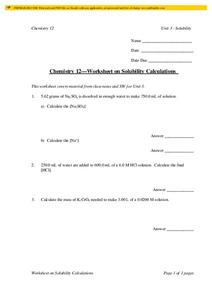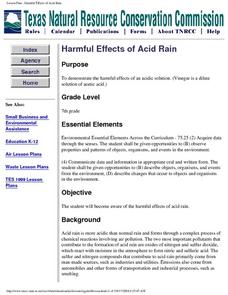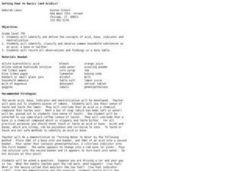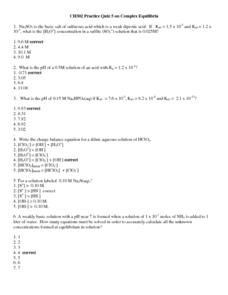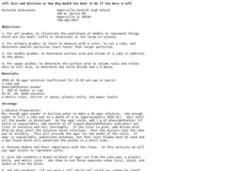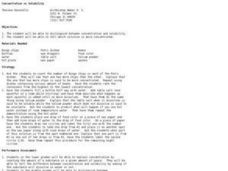Curated OER
One in a Million
Students participate in an experiment to demonstrate how a substance can have different concentrations in a solution. Students record observations on a dilution chart and determine the concentations of various parts per million.
Curated OER
Parts Per Million
Young scholars perform serial dilution of food coloring experiment with partner, examine concentration levels, and differentiate parts per million (PPM) and parts per billion (PPB). Students complete pre-lab and post-lab questions and...
Curated OER
Acids and Bases Worksheet
In this acids and bases worksheet, students determine the pH and pOH for a given solution. Students determine the conjugate acids for the given species. Students calculate which solution will have a higher pH. This worksheet has 16...
Curated OER
The Solution to Pollution is Dilution
Students consider what happens to herbicides or insecticides that are used in agricultural practices, especially herbicides that are used to control noxious weeds. They become acquaint with a chemical assessment method known as...
Curated OER
A Solution for Moles
Students calculate the concentration of different solutions. In this chemistry lesson, students explain what a solution is. They explain ways to change the concentration of a solution.
Curated OER
Acids and Bases
In this acids and bases learning exercise, students answer 18 questions about acids, bases, titrations, pH of solutions and the ions that make solutions acidic or basic.
Curated OER
Volumetric Analysis / Titration
Titration, and the lab skills that are needed to support it, is detailed here, with the reasoning behind standard solutions, concentration and volumetric analysis covered. Your young lab assistants will learn the skills of determining...
Curated OER
Solubility
For this solubility worksheet, students calculate the final concentrations of the ions involved in a chemical mixture. Students calculate the solubility of different compounds. This worksheet has 13 problems to solve.
Curated OER
Harmful Effects of Acid Rain
Seventh graders are able to demonstrate the harmful effects of an acidic solution. They become aware of the harmful effects of acid rain. Students make predictions before they began the experiment. If vingegar contains acid, then how...
Curated OER
The Chemical Detective
In this chemical detectives worksheet, students perform 6 tests on various unknown solutions including a test for chloride ion, sulphate ions, carbonate ions, iron (III) ions, iron (II) ions and copper (II) ions. Students record their...
Curated OER
Stoichiometry
In this stoichiometry worksheet, students review definitions and equations associated with molarity, density, atomic mass, molarity, and dilutions. This worksheet has 18 word problems.
Curated OER
Rates of Reaction: Indigestion Remedies
In this reactions worksheet, high schoolers compare the reaction of two different indigestion tablets with dilute hydrochloric acid and plot the results of loss of mass against time. Then students complete 5 short answer questions.
Curated OER
Getting Down to Basics (and Acidics)
Seventh graders investigate acids and bases. In this acids and bases lesson, 7th graders use household items such as coffee, lemons and soap to define acids and bases. They observe a demonstration to show how indicators determine if a...
Curated OER
Acids/Bases and Buffers
In this acids, bases and buffers worksheet, students define terms, solve problems such as calculating the pH of solutions and the molarity of solutions and they write balanced equations of neutralization reactions.
Curated OER
Balancing Redox Reactions
In this redox reaction worksheet, students perform a redox titration in order to determine the number of iodide ions which react with each mole of iodate (V) ions in a solution. Students calculate their answer using a given...
Curated OER
Complex Equilibria Quiz
In this equilibrium worksheet, students answer 8 multiple choice questions but need to solve the problems in order to determine the answers. They include determining the concentrations of ions as well as the pH of solutions.
Curated OER
Cell Size and Division or How Big Would You Want To Be if You Were a Cell?
Students investigate why cells divide. In this cell size lesson plan, students observe how far a solution travels into 3 different size model cells of agar. They answer questions about the most effect movement of "nutrients" into the...
Curated OER
Diffusion
Students investigate diffusion using different solutions of chemicals placed in agar dishes. In this diffusion lesson plan, students observe 3 demonstrations of diffusion using perfume, food coloring in water and sugar cubes in water....
Curated OER
Finding the Percent of Iron in Lawnsand
In this percent of iron in lawnsand instructional activity, learners perform a titration of lawnsand using potassium manganate (VII) solution and find the number of moles of iron in the sample. Students use the number of moles to find...
Curated OER
Concentration vs. Solubility
Students investigate the concentrations of solutions and solubility. In this concentrations and solubility lesson plan, students compare solutions of talcum powder in water and salt in water to have a visual of solubility. They perform...
Curated OER
Infectious Disease Detectives
Students participate in a simulation of how diseases are transmitted. Each student holds a test tube, with only one containing the "disease" while the others have water. They move around the room until told to stop. Using droppers to...
Curated OER
Acidity of Foods
Learners investigate the acidity of foods using titration. In this acidity of foods lesson plan, students find the acid concentration of 4 fruit juices by titrating them each with sodium hydroxide and an indicator to find the end point. ...
Curated OER
Protein Assays: Bio Rad and Page Gels
Students conduct the Biuret Test and the Bio Rad Protein Assay. They examine the spectrophotometer and graph molecular weights and the concentrations of the proteins investigated. They prepare solutions for the Bio-Rad test and use the...
Curated OER
Acids and Bases
In this acid and base worksheet, learners solve five problems using the volume and molarity of solutions in order to find the concentration of the acid or base in each given problem.









